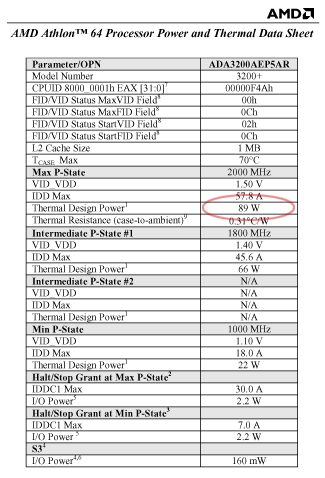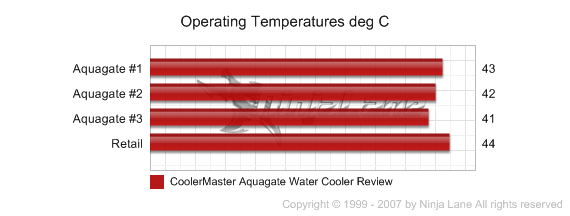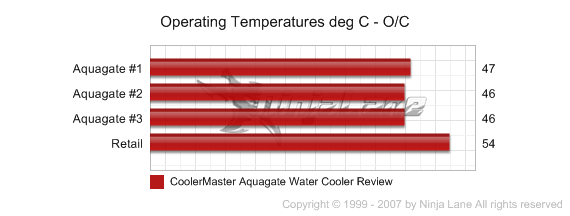After careful consideration I have decided to transfer all hardware review activities to a new domain. I purchased Hardwareasylum.com in 2012 and have been working hard to build a new and improved Ninjalane on that domain. If you are reading this you have reached one of the archived articles, news, projects and/or reviews that were left behind during the site migration.
Please update your bookmarks and be sure to visit the new and improved Ninjalane at Hardwareasylum.com
CoolerMaster Aquagate Water Cooler Review
Author: Dennis Garcia
Published: Friday, August 27, 2004
Benchmarks
The Cooler Master Aquagate is designed for all types of current processors. Here is an overview of the system and testing methodology.
Soltek SL-K8AV-R
Athlon64 3200+ 1MB L2 Cache
Cooler Master Aquagate ALC-U01
AMD Retail Heatsink
Motherboard Monitor was used to obtain and record system temperature information and a game of FarCry provided the processor usage.
Soltek SL-K8AV-R
Athlon64 3200+ 1MB L2 Cache
Cooler Master Aquagate ALC-U01
AMD Retail Heatsink
Motherboard Monitor was used to obtain and record system temperature information and a game of FarCry provided the processor usage.
Editors note: Even though the Windows XP task manager reported 100% processor usage we could never attain a 100% of the rated heat output as documented by AMD (see below)
when using FarCry as a basis for that heat production. Knowing this the game was played until the maximum temperature was attainted and stabilized, or when the round was over.
Other things to consider when judging software induced heat output.
a) Clock throttling by the processor at high temperatures.
b) Normal software isn't designed to produce maximum heat output.
c) Variances of cooling temperature.
d) Variances in CPU load.
e) Inaccuracies in thermal diode readouts.
Of course the list goes on..
My testing methodology is aimed to provide a real world look into this heatsink given the test system provided.
a) Clock throttling by the processor at high temperatures.
b) Normal software isn't designed to produce maximum heat output.
c) Variances of cooling temperature.
d) Variances in CPU load.
e) Inaccuracies in thermal diode readouts.
Of course the list goes on..
My testing methodology is aimed to provide a real world look into this heatsink given the test system provided.

Aquagate Default Mhz

A C/W rating can quickly be calculated using this formula.
C/W = (CPU temp - Ambient temp)/(Variance(%) * CPU Watts)
Allowed variance for this test = 75%
CPU Watts = 89W
0.22 C/W = (43C - 28.5C)/(.75(89W))
C/W = (CPU temp - Ambient temp)/(Variance(%) * CPU Watts)
Allowed variance for this test = 75%
CPU Watts = 89W
0.22 C/W = (43C - 28.5C)/(.75(89W))
Aquagate Overclocking
For this next test the FSB was cranked up to 235Mhz and the test was re-run. To calculate a new C/W rating for this test we will need to factor in the increased processor
wattage. The formula and constants for this are listed below.
ocC/W = dCPU Watts * (ocMhz / dMhz) * (ocVcore / dVcore)2
ocMhz = 2350
dMhz = 2000
ocVcore = 1.70
dVcore = 1.50
The variance still applies for our C/W calcuation
Allowed variance for this test = 75%
CPU Watts = 134W
0.18 C/W = (47C - 28.5C)/(.75(134W))
ocC/W = dCPU Watts * (ocMhz / dMhz) * (ocVcore / dVcore)2
ocMhz = 2350
dMhz = 2000
ocVcore = 1.70
dVcore = 1.50
The variance still applies for our C/W calcuation
Allowed variance for this test = 75%
CPU Watts = 134W
0.18 C/W = (47C - 28.5C)/(.75(134W))

Benchmark Conclusion
These numbers cannot really be taken for face value due to the nature of this watercooling kit, but you will notice a trend as the heat output of the processor increases. Even though the Aquagate is able to absorb the extra heat output, it is no longer able to dissipate it. Given the variance for these tests while running overclocked the adjusted heat output was around 100W, making the Aquagate a good everyday watercooler but unsuitable for any extreme overclocking when the wattage output approaches 100W.
Keep in mind these calculations are provided for demonstration purposes only and may not reflect the actual lab tested C/W rating.
Keep in mind these calculations are provided for demonstration purposes only and may not reflect the actual lab tested C/W rating.

